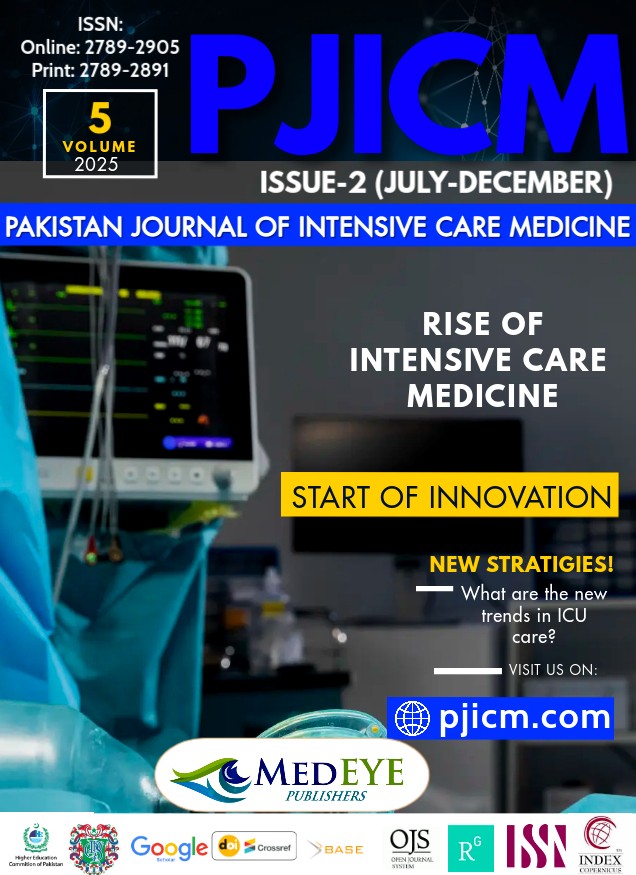FREQUENCY OF SUBARACHNOID HEMORRHAGE IN PATIENT PRESENTING WITH ACUTE STROKE
DOI:
https://doi.org/10.54112/pjicm.v5i02.198Keywords:
Acute Stroke, Subarachnoid Hemorrhage, Fisher Grading Scale, Ischemic StrokeAbstract
Background: Acute stroke is a leading neurological emergency, and rapid identification of underlying pathology is essential for appropriate management. Subarachnoid hemorrhage (SAH) is a less common but life-threatening cause of acute stroke, requiring urgent diagnosis and intervention. Evaluating its frequency in stroke presentations can support early detection and improved outcomes. Objective: To determine the frequency of subarachnoid hemorrhage in patients presenting with acute stroke. Study Design: Cross-sectional study. Setting: Department of General Medicine, DHQ Teaching Hospital, Dera Ismail Khan, Pakistan. Duration of Study: From January 2025 to July 2025. Methods: A total of 203 patients aged 40 years or older of either gender presenting with acute stroke within 48 hours of onset were enrolled. SAH was diagnosed based on radiological confirmation of blood in the subarachnoid space on CT scan and classified using the Fisher scale. Data were analyzed using SPSS version 25. Descriptive statistics were applied to determine SAH frequency and grading distribution. Results: The mean age of patients was 52.96 ± 9.62 years, with 58.1% males and 41.9% females. Subarachnoid hemorrhage was identified in 12 patients (5.9%). Among SAH cases, Fisher grade I was observed in 1 patient (8.3%), grade II in 3 patients (25%), grade III in 4 patients (33.3%), and grade IV in 4 patients (33.3%). Conclusion: SAH accounted for 5.9% of acute stroke presentations in the studied population. Most cases were categorized as Fisher grade III and IV, highlighting the importance of immediate radiological evaluation for severe SAH to guide timely management and improve patient outcomes.
References
Murphy SJ, Werring DJ. Stroke: causes and clinical features. Medicine (Abingdon). 2020;48(9):561-6. https://doi.org/10.1016/j.mpmed.2020.06.002
Tu WJ, Wang LD. China stroke surveillance report 2021. Mil Med Res. 2023;10(1):33. https://doi.org/10.1186/s40779-023-00463-x
Roger VL, Go AS, Lloyd-Jones DM, Adams RJ, Berry JD, Brown TM, et al. Heart disease and stroke statistics: 2011 update. Circulation. 2011;123(4):e18-209. https://doi.org/10.1161/CIR.0b013e3182009701
GBD 2016 Stroke Collaborators. Global, regional, and national burden of stroke, 1990-2016: a systematic analysis for the Global Burden of Disease Study 2016. Lancet Neurol. 2019;18(5):439-58. https://doi.org/10.1016/S1474-4422(19)30034-1
Claassen J, Park S. Spontaneous subarachnoid haemorrhage. Lancet. 2022;400(10355):846-62. https://doi.org/10.1016/S0140-6736(22)00938-2
Thilak S, Brown P, Whitehouse T, Gautam N, Lawrence E, Ahmed Z, et al. Diagnosis and management of subarachnoid haemorrhage. Nat Commun. 2024;15(1):1850. https://doi.org/10.1038/s41467-024-46015-2
Robba C, Busl KM, Claassen J, Diringer MN, Helbok R, Park S, et al. Contemporary management of aneurysmal subarachnoid haemorrhage: an update for the intensivist. Intensive Care Med. 2024;50(5):646-64. https://doi.org/10.1007/s00134-024-07387-7
Couret D, Boussen S, Cardoso D, Alonzo A, Madec S, Reyre A, et al. Comparison of scales for the evaluation of aneurysmal subarachnoid haemorrhage: a retrospective cohort study. Eur Radiol. 2024;34(11):7526-36. https://doi.org/10.1007/s00330-024-10814-4
Griswold DP, Fernandez L, Rubiano AM. Diagnosis and management of traumatic subarachnoid hemorrhage: protocol for a scoping review. JMIR Res Protoc. 2021;10(10):e26709. https://doi.org/10.2196/26709
Macdonald RL, Schweizer TA. Spontaneous subarachnoid haemorrhage. Lancet. 2017;389(10069):655-66. https://doi.org/10.1016/S0140-6736(16)30668-7
D’Souza S. Aneurysmal subarachnoid hemorrhage. J Neurosurg Anesthesiol. 2015;27(3):222-40. https://doi.org/10.1097/ANA.0000000000000130
Schievink WI, Wijdicks EF, Parisi JE, Piepgras DG, Whisnant JP. Sudden death from aneurysmal subarachnoid hemorrhage. Neurology. 1995;45(5):871-4. https://doi.org/10.1212/WNL.45.5.871
de Rooij NK, Linn FH, van der Plas JA, Algra A, Rinkel GJ. Incidence of subarachnoid haemorrhage: a systematic review with emphasis on region, age, gender and time trends. J Neurol Neurosurg Psychiatry. 2007;78(12):1365-72. https://doi.org/10.1136/jnnp.2007.117655
Birenbaum D, Bancroft LW, Felsberg GJ. Imaging in acute stroke. West J Emerg Med. 2011;12(1):67-76. (No DOI available.)
Sana S, Shoukat S, Tabassum S, Shahbaz H. Frequency of cerebral aneurysm in patients with subarachnoid hemorrhage on CT cerebral angiography. Pak J Med Sci. 2024;40(9):1975-8. https://doi.org/10.12669/pjms.40.9.8653
Alam S, Khan A, Sajjad M, Khan AA, Ahmad E, Ihsan A. Prevalence and distribution of intracranial aneurysms in patients with spontaneous subarachnoid hemorrhage in Hazara Division, Pakistan. Gomal J Med Sci. 2022;20(3):147-53.
Malik S, Sattar RA, Shah S, Rehman H, Tahira, Ismail MA. Frequency of QTc prolongation in patients with haemorrhagic stroke. J Ayub Med Coll Abbottabad. 2013;25(3-4):75-7.
Souter MJ. Critical care of subarachnoid haemorrhage. J Neuroanaesthesiol Crit Care. 2017;4(Suppl 1):S49-55. https://doi.org/10.4103/jnacc.jnacc_75_16
Patel S, Parikh A, Okorie ON. Subarachnoid hemorrhage in the emergency department. Int J Emerg Med. 2021;14(1):31. https://doi.org/10.1186/s12245-021-00353-w
Lv B, Lan JX, Si YF, Ren YF, Li MY, Guo FF. Epidemiological trends of subarachnoid hemorrhage at global, regional, and national level: a trend analysis study from 1990 to 2021. Mil Med Res. 2024;11(1):46. https://doi.org/10.1186/s40779-024-00551-6
Downloads
Published
How to Cite
Issue
Section
License
Copyright (c) 2025 A ESSA , S JAVED , D WALI , IA SHAH , RU HAYAT , IU HAQ

This work is licensed under a Creative Commons Attribution-NonCommercial 4.0 International License.












